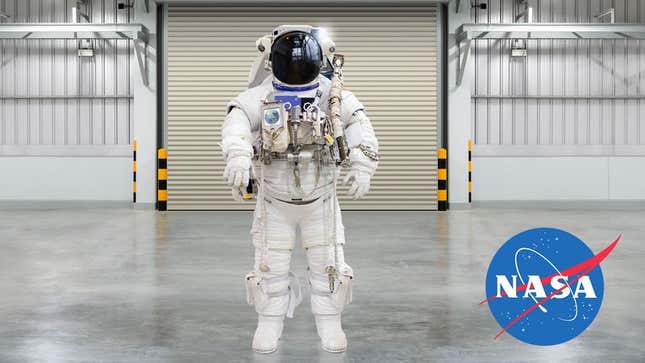
WASHINGTON—Saying the groundbreaking new technology could allow humans to withstand the harsh conditions they will experience on the planet’s surface, NASA confirmed Tuesday that it has created a climate-controlled suit capable of protecting people who hope to one day live on Earth.
Agency officials told reporters that the suit, which they have named the Terrestrial Mobility Unit, is specifically engineered to keep humans safe from the extreme temperatures and unbreathable atmosphere found on Earth, increasing the possibility that, decades from now, they may be able to inhabit the dangerous planet.
“Our team has finally created a functional, reliable space suit that humans may someday use to survive the punishing environment they encounter on Earth,” said NASA senior research scientist Catherine Seltzer, who spearheaded the 12-year, $180 million project and helped devise the unique polymers that allow the suit to endure a nonstop bombardment of intense ultraviolet radiation. “From the devastating storm systems sweeping the planet to the many toxic gases filling its atmosphere, Earth will be hostile to human life. But with the Terrestrial Mobility Unit, a person may actually be able to walk safely across its surface.”
“As incredible as it sounds, we might even have a permanent human settlement on Earth 100 years from now,” she added.
According to NASA, the suit contains a state-of-the-art environmental control system that uses water vaporization to cool the wearer in the midst of scorching temperatures and that filters out poisonous levels of carbon dioxide to maintain oxygen supplies, allowing a person to survive for extended periods of time in the Earth’s unforgiving terrestrial climate. In addition, an impenetrable semirigid fiber has reportedly been incorporated into the suit as protection against an atmosphere expected to be ridden with dense particulate matter, including an unknown number of highly lethal toxins.
“Even the slightest contact with the Earth’s atmosphere will quickly prove fatal, so we’ve taken every conceivable precaution,” said NASA engineer James Mullen, explaining that computer simulations showed that unprotected humans exposed to the planet’s sun for any amount of time would immediately suffer fourth-degree burns all over their bodies. “The suit has even been specially fortified with a new high-density polymer-metal composite that can act as a defense in the event of extreme weather events such as acid rain downpours, continent-spanning dust storms, and clusters of Category 5 hurricanes, any one of which can occur at any time, without warning, and last for years.”
Mullen went on to say that even a tiny pinprick in the Terrestrial Mobility Unit would cause its wearer to die a horrific death, though there remains debate as to what would kill the person first—extreme temperature, asphyxiation from low oxygen, or the planet’s wildly fluctuating air pressure, which would either boil off a human’s blood or simply crush him or her flat.
Despite the substantial protections afforded by the suit, NASA officials were quick to point out that even while wearing it, no human could remain on the Earth’s surface for more than three or four hours before having to retreat to a titanium-reinforced bunker hundreds of feet underground.
“The truth is, we won’t know just how the suit will respond to being on Earth until we take those first brave steps 50 or 60 years from now,” Mullen said. “We can run all the tests we want, but at the end of the day we’ll be placing actual human beings on a highly unstable planet with an environment that is extremely unsafe, not just for us, but for all carbon-based life.”
“All we can do right now is to continue upgrading our design and hope for the best,” he added.
A NASA spokesperson confirmed that excitement for the project has resulted in an accelerated production schedule that could conceivably allow thousands of human beings to be living on Earth by 2075.